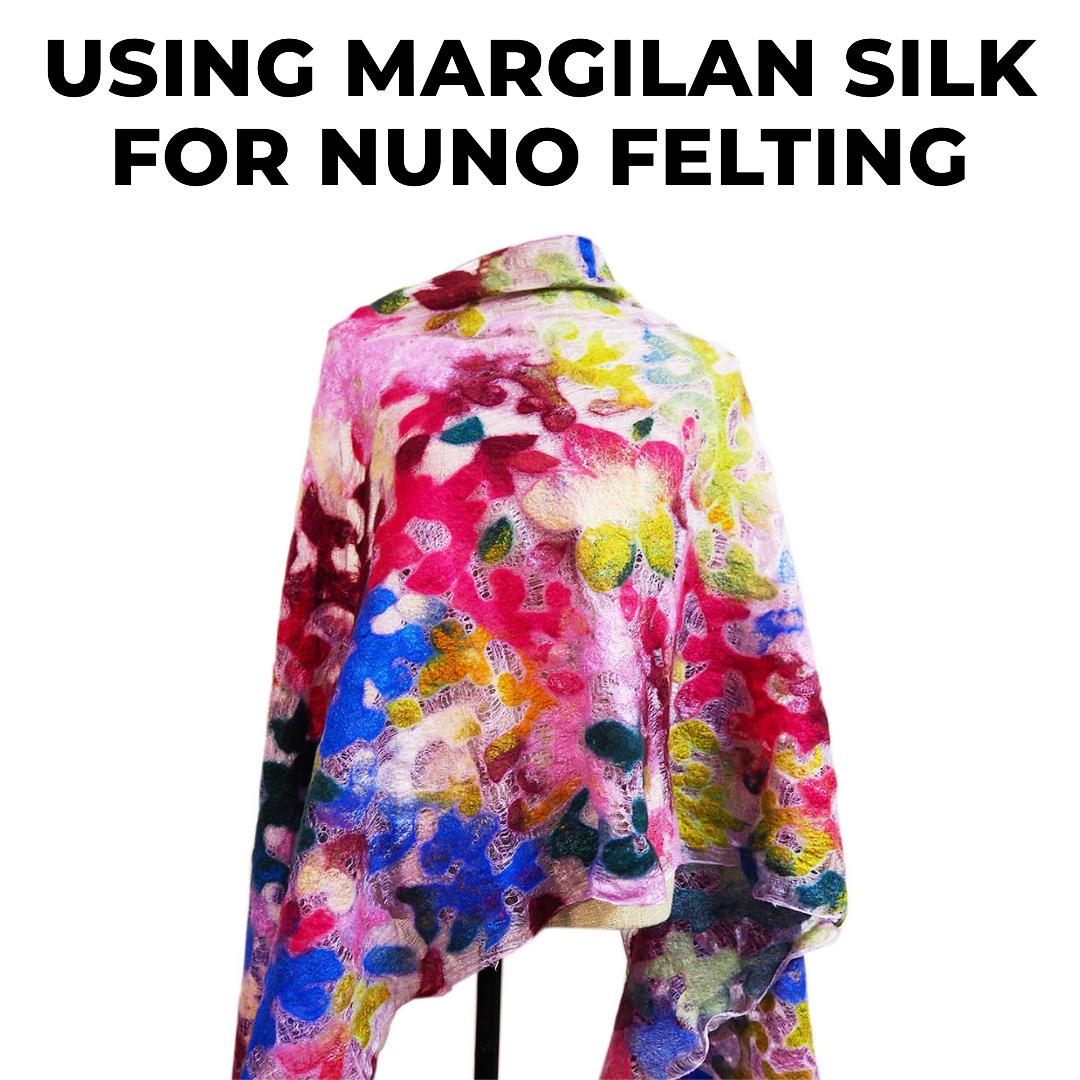US$99 OR MORE


The word “nuno” is Japanese for “cloth”. Nuno felting is a type of wet felting in which you combine loose wool fibres with a piece of any open weave fabric. The thinner the fabric, the better it bonds with the wool. The textile layer gives the felt strength and makes it look smooth and shiny. You can shape the material into waves, flowers, tree bark or any other texture, or just lay it flat. You can also use a small patch of Nuno Felt to add life and sparkle to decorate any item fancifully with only small patches of nuno felt! The texture you produce is much lighter than an all-wool felt – you can use but one thin layer of fibres, but the item will not fall apart. Developed by Polly Stirling from Australia in the early 1990s, the technique gives boundless opportunities for fashion designers, fabric artists and anyone who enjoys felting as a hobby.
The basic principle is the same as for wet felting. The invisible scales on the wool fibers spread out and entangle under the effect of soapy water, and, voila, a heap of wool turns into dense texture. The woven material that you use as the base is very light and airy, so the wool fibers penetrate through it and catch together. When the wool has felted thoroughly, you cannot tear it from the cloth.

The most common textile for nuno felting is Margilan Silk, produced in Uzbekistan. To be more precise, it is a type of Silk Gauze. It is rapidly gaining popularity among felters as a perfect option for light summer dresses, shawls, scarves, pinafores and skirts. Some felt makers use Cotton Gauze, others prefer Chiffon or Polyester. You may use any material, provided it is thin enough.
A GREAT IDEA! Haven’t yet thrown away that yucky old polyester scarf? Turn it into a luxury item using affordable materials and a bit of grit!
For Nuno Felting, you can use the same materials as for Wet Felting, plus a piece of fabric. The water should be cold rather than warm, otherwise the fibres will entangle before they penetrate the textile, and the felt will not bond with the cloth.
● Unspun wool (Corriedale or Merino wool roving, carded wool, prefelt or even raw sheep or alpaca fleece). Use extra fine Merino for fine and delicate projects;
● Cotton or silk gauze or any other material, mentioned above;
● Optionally – decorative fibers (muga silk, tussah silk, viscose etc);
● Cold water, high quality soap and rubber gloves – do care about your hands!
● Bubble wrap;
● A piece of synthetic tulle or tutu net, larger than the size of the project;
● A rolling pin, foam pool noodles or a PVC pipe;
● For some 3D projects you can cut templates from thick plastic film called “resist”;
● A water sprayer.
The procedure is similar to that of wet felting, but you use the fabric as the base and fewer fibre layers are needed. This is just an overview of the process, not a detailed workshop. I strongly recommend watching a video before you start.
1. Lay one or more layers on the gauze or other cloth, spread over a piece of bubble wrap. Make sure it is evenly distributed over the fabric. Add design elements with wool, silk or viscose fibres. Don’t limit your imagination!
2. Cover the project with tulle or tutu net.
3. Spray with cold water and apply soap on the net. Take care not to disturb the wool and not to ruin the design!
4. Start the felting process by gently rubbing the wool in circular motions through the net. Continue rubbing for 3-5 minutes, applying light pressure.
6. Keep gently rubbing in circular motions without the net. After a while (10-15 minutes later), you’ll feel the wool shrinking and texture beginning to change.
7. Now you can knead the wool like dough, roll it between your palms etc. As you are felting, you’ll notice the wool penetrate and compress the fabric, forming a rough, ruffled texture. Felt on until you are sure that the wool has entirely passed through the cloth and sticks to it tightly.
8. The article is nearly ready. Wash it in running water, alternating between warm and cold water, in order to facilitate shrinking.
9. Rinse your scarf in fresh water.
10. Dry the item and carefully iron it, if necessary.
Remember these are not detailed instructions, just a general idea. For more details, please browse the Internet for samples of videos, e-books and learning materials.